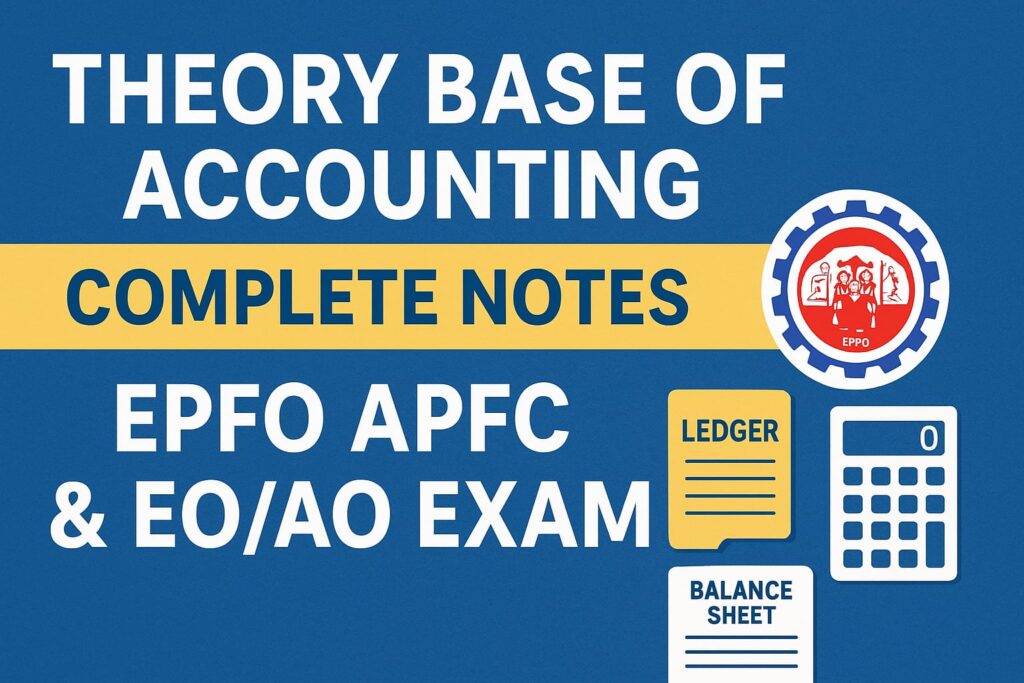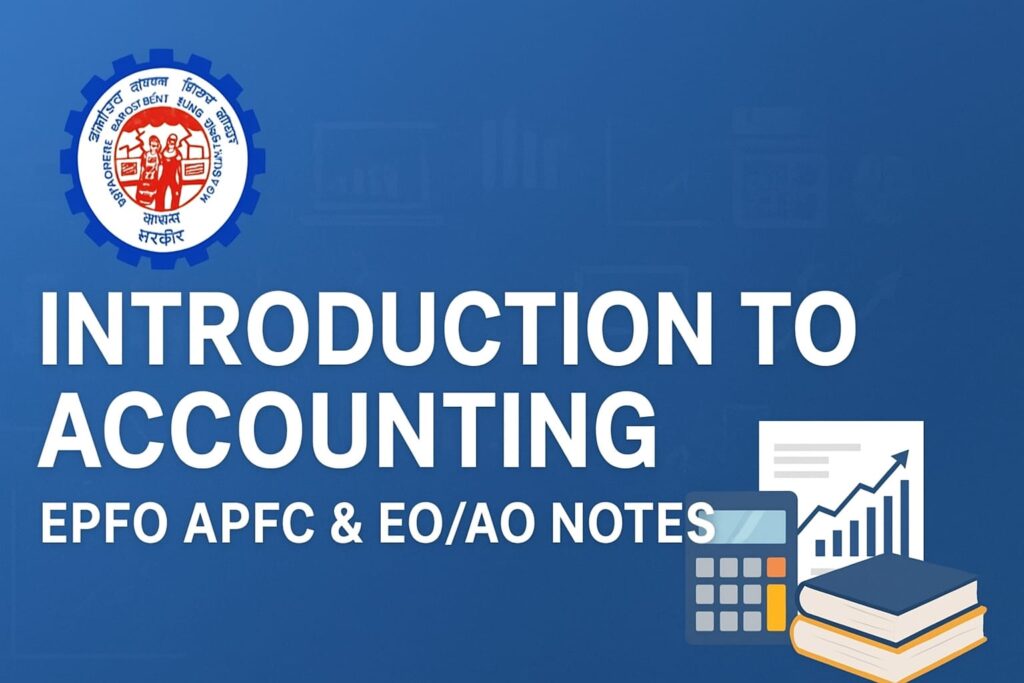If you are preparing for the EPFO APFC (Assistant Provident Fund Commissioner) or EPFO EO/AO (Enforcement Officer/Accounts Officer) exam, mastering the Theory Base of Accounting is crucial. This topic forms a fundamental part of the “General Accounting Principles” section, which is one of the most scoring areas in the exam.
Most questions in the accounting section of EPFO are conceptual and definition-based. They test your understanding of the basic principles, assumptions, and concepts behind accounting — not complicated calculations. This makes the theory base a must-read topic for every aspirant.
In this comprehensive guide, we will cover everything you need to know — including accounting principles, concepts, conventions, fundamental assumptions, and key terms — explained clearly and concisely for quick revision.
📊 What is the Theory Base of Accounting?
The theory base of accounting refers to the fundamental principles, concepts, conventions, and assumptions that form the foundation of accounting practice. These principles guide how financial transactions are identified, measured, recorded, and reported, ensuring accuracy, consistency, comparability, and reliability in financial statements.
In simple words, the theory base of accounting is like the grammar of the accounting language — without it, financial information would be inconsistent and unreliable.
📚 Importance of Accounting Principles in EPFO Exam
Understanding accounting principles is essential for several reasons:
✔️ They provide a standard framework for recording financial transactions.
✔️ They ensure consistency and comparability across financial statements.
✔️ They make financial reports reliable and decision-useful.
✔️ They are the foundation of many MCQs and case-based questions in the EPFO exam.
🧾 Tools Ensuring Consistency in Accounting
To maintain uniformity and reliability, accounting relies on two major tools:
1. GAAP (Generally Accepted Accounting Principles)
A set of common accounting rules and standards used globally.
Ensures consistency, comparability, and transparency in financial reporting.
2. Accounting Standards
Detailed guidelines issued by ICAI (Institute of Chartered Accountants of India).
Provide standardized methods for recording and reporting various financial transactions.
📘 Key Accounting Concepts and Principles
Below are the most important accounting concepts that form the backbone of accounting theory. They are frequently asked in EPFO APFC & EO/AO exams.
1. Business Entity Concept
The business and its owner are treated as separate legal entities.
The owner’s investment is a liability from the business’s perspective.
Personal transactions are not recorded in business accounts.
✅ Example: If the owner invests ₹5,00,000 in the business, it is recorded as “Capital” — a liability.
2. Money Measurement Concept
Only transactions that can be measured in monetary terms are recorded.
Non-monetary aspects (like employee skill, goodwill, brand reputation) are not recorded.
✅ Example: ₹50,000 salary expense is recorded; employee performance quality is not.
3. Periodicity Concept
The life of a business is divided into fixed accounting periods (usually a year) for reporting.
Allows periodic comparison of performance and financial position.
✅ Example: Income statements are prepared for 1st April to 31st March each year.
4. Revenue Recognition Concept
Revenue is recognized when the right to receive is established — not necessarily when cash is received.
In long-term contracts, revenue may be recognized proportionately.
✅ Example: If goods worth ₹1,00,000 are sold on credit, revenue is recorded at the time of sale, not payment.
5. Accrual Concept
Revenues and expenses are recorded when earned or incurred, not when cash is exchanged.
Forms the basis of modern accounting.
✅ Example: Rent due in March but paid in April is recorded in March books.
6. Matching Concept
Expenses should be matched with the revenue of the same accounting period.
Ensures correct calculation of profit or loss.
✅ Example: Raw material used for goods sold in this year is treated as an expense this year.
7. Going Concern Concept
Assumes the business will continue operations in the foreseeable future.
Assets are valued based on future utility, not liquidation value.
✅ Example: Machinery is depreciated over its useful life instead of being recorded at current market value.
8. Cost Concept
Assets are recorded at their original cost (purchase price + related expenses), not current market value.
✅ Example: A machine bought for ₹5,00,000 is recorded at ₹5,00,000 even if its market value is ₹7,00,000 later.
9. Dual Aspect Concept
Every transaction affects two accounts (debit and credit).
Forms the basis of the accounting equation:
👉 Assets = Liabilities + Capital
✅ Example: Buying furniture worth ₹50,000 (Asset ↑) on credit (Liability ↑).
10. Full Disclosure Concept
All relevant financial information must be disclosed in statements or footnotes.
Helps users make informed decisions.
✅ Example: Contingent liabilities must be disclosed even if they are not certain.
11. Consistency Concept
Accounting methods must remain consistent over time to enable meaningful comparison.
✅ Example: If depreciation is calculated using the straight-line method, it should not change every year.
12. Conservatism (Prudence) Concept
Anticipate losses, not profits. Record potential losses immediately, but record gains only when realized.
Prevents overstatement of income and assets.
✅ Example: If inventory cost is ₹10,000 and market value is ₹8,000 — record it at ₹8,000.
13. Materiality Concept
Focus only on information that is significant to financial decisions.
Minor items can be ignored or aggregated.
✅ Example: Stationery expenses may be recorded as an expense immediately instead of being treated as an asset.
14. Objectivity Concept
All recorded transactions must be backed by verifiable evidence like invoices or receipts.
Ensures reliability and eliminates bias.
✅ Example: A sale is recorded based on a sales invoice.
📉 Fundamental Accounting Assumptions
Three key assumptions are always presumed to be followed in accounting:
1. Going Concern: Business will continue operations in the foreseeable future.
2. Consistency: Accounting methods and policies remain unchanged over time.
3. Accrual: Revenues and expenses are recognized when earned/incurred, not when cash is received/paid.
🧠 Quick MCQ Insights for EPFO APFC & EO/AO
Periodicity Concept: Divides business life into accounting periods.
Revenue Recognition: Revenue recorded when sale is made, not when cash is received.
Matching Concept: Links expenses to corresponding revenues.
Cost Concept Violation: Recording asset at market value instead of purchase cost.
Conservatism: Losses recorded immediately; gains recorded when realized.
Dual Aspect: Every transaction has two effects.
📌 Tips to Master This Topic for EPFO Exam
📚 Revise Definitions: Most questions are definition-based and conceptual.
🧠 Understand Logic: Know why each principle is applied, not just what it means.
🧾 Solve PYQs: Past year EPFO questions often repeat similar concepts.
🧩 Use Real-Life Examples: It helps in remembering concepts quickly during the exam.
🏁 Final Words
The Theory Base of Accounting is one of the most important topics in the EPFO APFC and EO/AO syllabus. It builds the foundation for understanding all other accounting topics and forms a large portion of the questions asked in the exam.
By mastering these principles — from Entity and Accrual to Matching, Conservatism, and Full Disclosure — you not only improve your scoring potential but also gain conceptual clarity that helps in other parts of the exam as well.
Remember, in EPFO exams, clarity is more important than complexity. Focus on building strong basics, practice MCQs regularly, and revise these concepts thoroughly before the exam.


